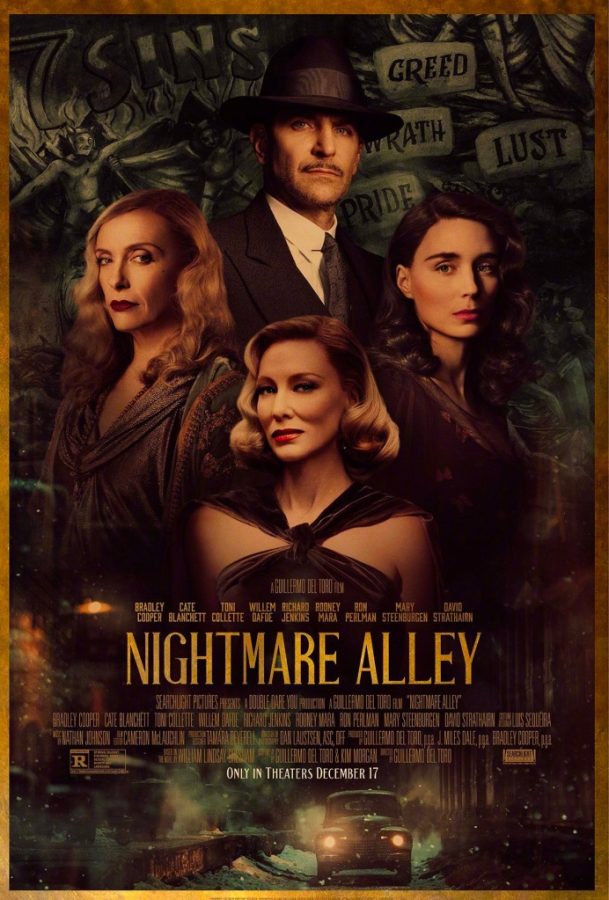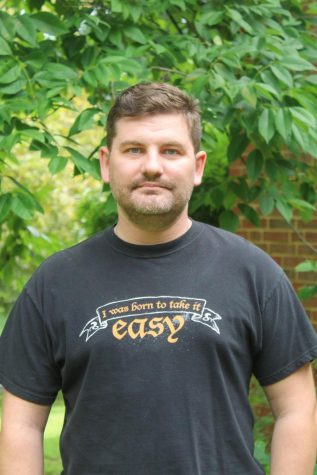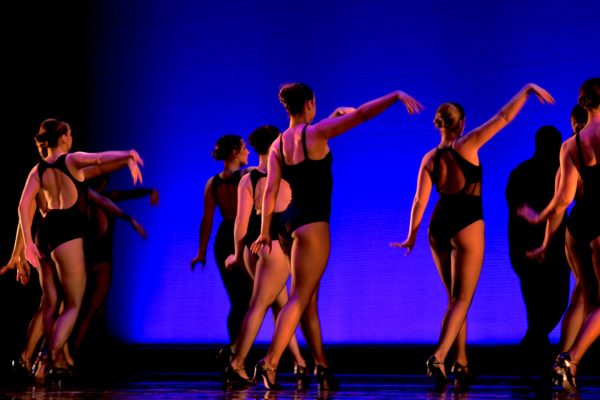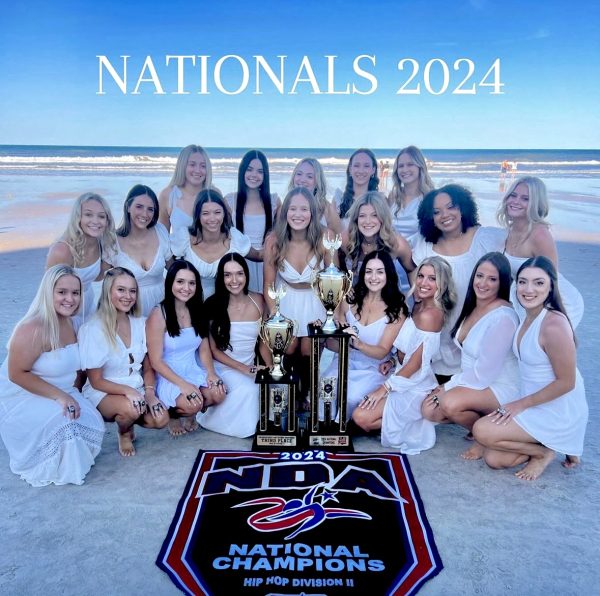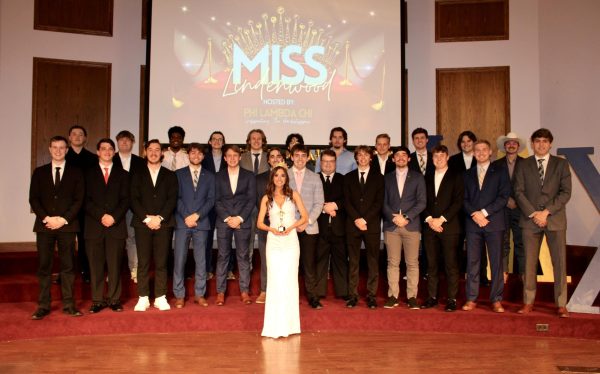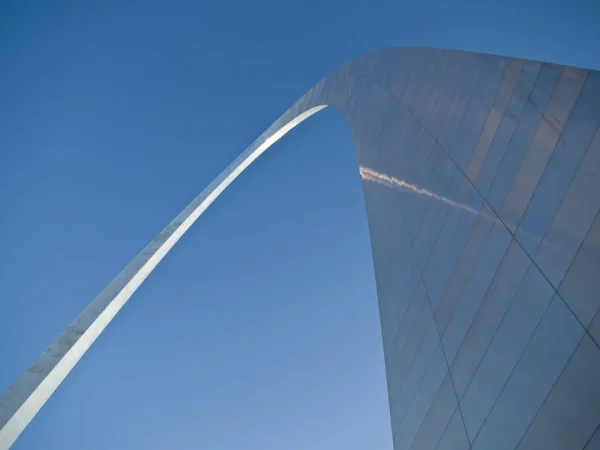Review: “Nightmare Alley” – Del Toro’s modern film noir
March 3, 2022
Beware the descent into Nightmare Alley: a twisting, dark path full of dead ends and filth that will exploit your fears and dark secrets. Once lost, your choices will turn to desperations and your life-a prison. Once you know you’re in Nightmare Alley, it is all but too late.
That’s not anything from the movie; I was just trying to sound fancy and poetic-like.
“Nightmare Alley” is based on the 1946 novel, and is the second adaptation after the 1947 film. Having never read the novel, it sounds like this version combines elements of both the novel and the 1947 film. However, the 1947 version ending held a minor happy ending compared to its novel.
“Nightmare Alley” is directed by Guillermo del Toro, who also wrote the film with co-writer Kim Morgan. Del Toro’s more popular films are probably his action films, such as “Hellboy,” Pacific Rim,” and “Blade II.” Del Toro’s more serious films would take bizarre and unusual angles, such as his dark elf fantasy “Pan’s Labyrinth,” his gothic horror/drama “Crimson Peak,” and his Oscar-winning romance of a woman in love with the fish guy: “The Shape of Water.”
“Nightmare Alley” stars Bradley Cooper (“The Hangover” series) as Stanton Carlisle, Cate Blanchett (“The Lord of the Rings” films) as Dr. Lilith Ritter, Rooney Mara (“The Girl with the Dragon Tattoo” remake) as Molly Cahill, Richard Jenkins (“The Shape of Water”) as Ezra Grindle, Toni Collette (“Hereditary”) as Zeena the Seer, Willem Dafoe (“Platoon”) as Clem Hoatley, Ron Perlman (“Hellboy”) as Bruno.
The story starts off when drifter Stanton Carlisle joins a traveling carnival as a “carny.” Carlisle learns the secrets of the other acts, including clairvoyant and “geek” shows which are revealed to all be staged. Being a quick study, Carlisle dreams up his own “cold-reading” (technique of using high-probability guesses and signals by reading someone’s body language, mannerisms, age, etc.) scheme with Molly Cahill, another performer. Together, they leave the carnival to start a new life ripping rich people off in Buffalo, NY in a fake psychic act, influenced by everything he’d learned.
Carlisle’s psychic act gains the attention of psychologist Lilith Ritter, who deduces that he is a con man and wants to use his talents on her wealthier clients. Carlisle sets his sight on one client, Ezra Grindle, a violent and abusive man. But as his act pokes further into Grindle’s loss, Carlisle will find dire consequences for his deceitful career.
“Nightmare Alley” is a modern take off the “film noir” genre, which were usually crime dramas and detective mysteries. French for “dark film,” it is a style or genre using elements like cynical heroes, stark lighting, a lot of flashbacks, intricate plots, and underlying existentialist philosophies. Think of those old private eye films, where the detective is wearing a trench coat and walking down dark streets at night while talking out loud about the “lowlifes” and “scumbags” in the city. Add in a saxophone soundtrack and bingo, film noir.
Modern film noir are referred to as “neo-noir” since the ‘60s. They’ve popped up from time to time, even in the last 20 years from 2001’s “Training Day” to 2014’s “Nightcrawler.”
This film really draws you in from the beginning. The first scene shows Carlisle burying a wrapped body before burning a house with no exposition. It’s an alluring way to start a story with the main character and it stays in the back of the viewer’s mind as the plot continues. You know there’s something dark going on with him but have to wait to see what that scene really was.
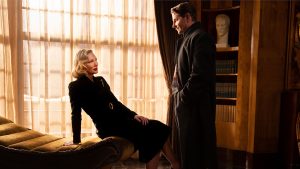
What throws off a lot of people with the film is its title. “Nightmare Alley” sounds like a horror film, like this might be a Carnival of the Damned type movie. In reality, the title is part of what Dafoe’s character refers to in how he gets “temporary” carnies to stand in for his geek show. He promises alcoholics a temporary job until they can find a real geek (carnival’s disfigured or bizarre attractions, in this case) to replace them. But Dafoe uses their dependence to turn them into the real attraction, creating the illusion of these desperate men as freaks of nature. These hard-luck men come from Nightmare Alley, a darkened, dead-end frame of mind where people can and will do almost anything to get out.
The performances are full of great acting, especially from Cooper and Blanchett. Blanchett pulls off her psychologist character in a “femme fatale” type, which is a common trope in film noir. In “Nightmare Alley,” Ritter easily lures Carlisle into using his acts to exhort her rich clients. While it would be easy to call her more of a villain, she is basically aiding the main character with what he was already doing, just with higher stakes. Even in the ‘40s, Ritter stands as a powerful woman over men with her profession and keeps Carlisle in line (most of the time) with charm and sexuality. The scenes with both Blanchett and Cooper are probably some of the highlights of the film; both acting off each other dynamically and building stronger tension with each scene.
A month after its initial release, the film was re-released to select theaters in a black-and-white version, titled “Nightmare Alley: Vision in Darkness and Light.” This version was initially only available to Los Angeles, but its success has broadened to over 1,000 theaters nationwide. Unfortunately, I didn’t see it available in this area, but I would have loved to see that. Maybe it’ll be an option when it’s out on DVD/Blu-Ray/4K.
“Nightmare Alley” is currently in theaters and is now streaming on Hulu and HBO Max.



